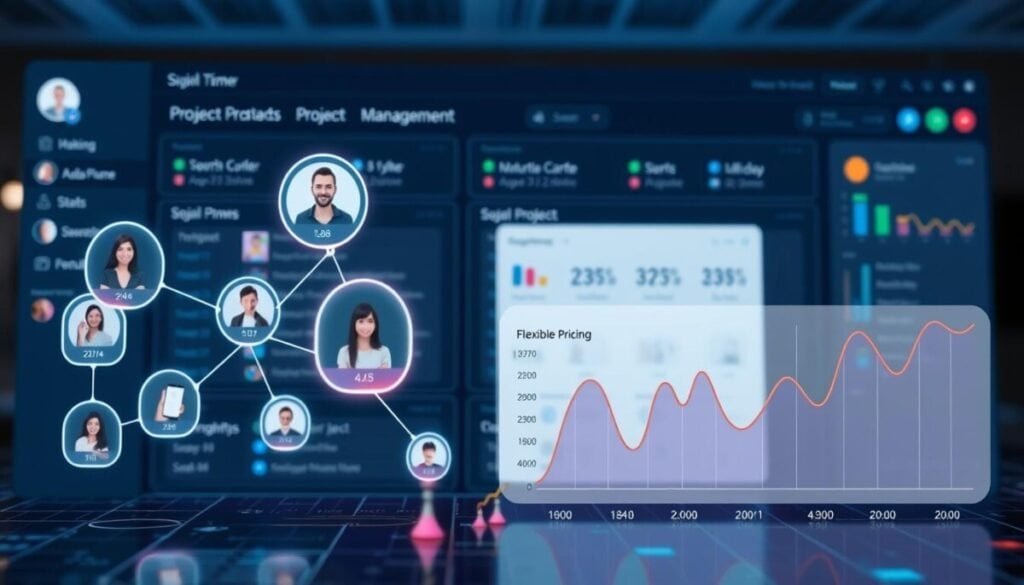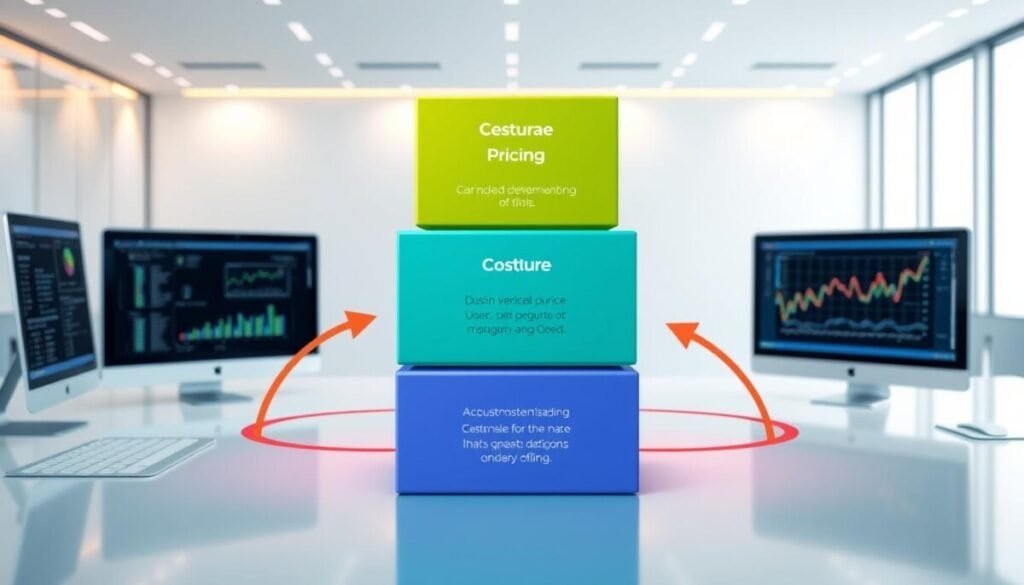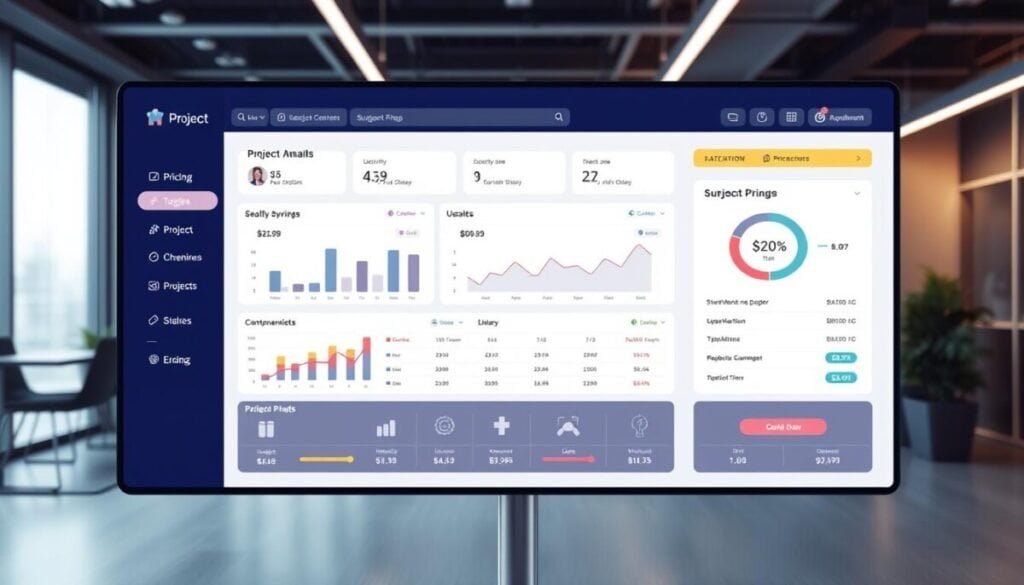Managing projects can be tough, especially when we have to watch our budget. Remember that time when our team was stuck with spreadsheets and missed deadlines? It was a common problem that made us look into project management software pricing models.
Finding the right software can change how we work, but the cost is a big factor. It’s all about finding a balance between what we need and what we can afford. As we look at different pricing models, we’ll find ways to estimate costs that won’t hurt our budget.
From small startups to big companies, almost 80% of successful projects use good project management tools. But with prices ranging from free to hundreds per user, picking the right one is hard. Let’s look at the options together, from models that grow with our team to flat fees that make budgeting easier.
Key Takeaways
- Project management software pricing varies widely, from free to enterprise-level costs
- Different pricing models cater to diverse organizational needs and sizes
- Software budgeting requires balancing features with financial constraints
- Subscription-based models offer flexibility and regular updates
- Free and open-source options provide basic functionalities without upfront costs
- Negotiating costs and opting for annual plans can lead to potential savings
Understanding Project Management Software Pricing Structures
Project management software pricing can be complex. We’ll explore different models to help you make informed decisions for your project tracking expenses and finance management needs.
Subscription vs. Perpetual Licensing
Subscription models offer flexibility with monthly or annual fees. They’re great for businesses that want to avoid data hosting. Perpetual licensing requires a one-time payment and suits companies concerned with data security. The average cost for small businesses is $8.90 per user monthly, with prices ranging from $4 to $19 based on features.
Cloud-Based vs. On-Premise Solutions
Cloud-based options provide scalability and lower initial costs. On-premise solutions offer greater control but may require more upfront investment. Nearly 80% of high-performing projects use robust project management software, highlighting the importance of choosing the right solution.
The Impact of Pricing on Software Selection
Pricing structures significantly affect long-term costs and flexibility. Pay-per-user models offer transparency but can be costly for large teams. Flat fee pricing ensures predictable costs regardless of user count. Tiered pricing allows businesses to select packages matching their needs and budget. Usage-based pricing aligns costs with actual activity levels, ideal for project tracking expenses.
When selecting software, consider your team size, project complexity, and budget. Many providers offer free plans with limited features, while paid plans start from $2.33 per month for single users. Remember, annual subscriptions often provide better value than monthly payments.
Pay-Per-User Model: Scalability and Flexibility

The pay-per-user model is a common choice for project management software. It charges based on how many people use the system. About 78% of SaaS companies use this model, making it very popular.
Tools for managing resources and accounting for projects often use this model. For example, Salesforce Sales Cloud has plans at $25, $80, or $165 per user per month. This depends on the features you choose.
This pricing helps businesses with clear team structures. It makes it easy to grow as the company does. With 82% of SaaS providers seeing revenue grow with more customers, it’s a flexible choice.
It lets you add or remove user licenses as needed. This keeps costs in line with how much you use it.
| Advantages | Considerations |
|---|---|
| Predictable costs | Potentially expensive for large teams |
| Easy budgeting | May limit access for occasional users |
| Scalability | Not ideal for sporadic usage |
Small to medium-sized businesses find this model easy to handle. It’s great for companies that grow in value with more users. But, it might not work for services based on outcomes or in very competitive markets.
Flat Fee Pricing: Simplicity and Predictability

Flat fee pricing is simple and clear. It means paying a fixed price for unlimited access, no matter how many users. This is great for businesses that want to know exactly what they’re spending on agile project costs.
Advantages for Large Organizations
Big companies love flat fee pricing. It makes budgeting easy and lets everyone use the tool without limits. This approach is open and honest, with no surprise fees. It helps in planning and using resources well.
Potential Drawbacks for Smaller Teams
For small teams, flat fee pricing might not be the best. They might pay too much if they don’t use the tool a lot. It also doesn’t adjust well when a team grows or uses less of the software.
Budgeting Considerations
Thinking about flat fee pricing for project management tools? You need to know your needs well. It’s best for services that grow and repeat. Make sure to look at all costs to stay profitable.
| Aspect | Impact on Budgeting |
|---|---|
| Predictability | Easier to project earnings and manage profitability |
| Billing Process | Simplified, leading to higher customer satisfaction |
| Cash Flow | More stable and predictable over time |
| Cost Analysis | Requires careful consideration of fixed and variable costs |
Flat fee pricing makes agile project costing easier. It’s simple and predictable, appealing to many. Knowing its pros and cons helps decide if it’s right for your project management needs.
Tiered Pricing: Customizable Options for Growing Businesses

Tiered pricing is a flexible way to handle project management software costs. It divides pricing into different tiers based on user numbers or product use. As more users join, the cost per user often drops, helping growing teams save money.
Let’s look at a typical tiered pricing setup for project management tools:
| User Range | Price per User (Monthly) |
|---|---|
| 1-5 Users | $10 |
| 6-10 Users | $9 |
| 11-20 Users | $8 |
| 21+ Users | $7 |
This pricing model lets businesses start small and grow as needed. It’s great for companies with changing needs or those adding custom features. It fits well with waterfall project pricing, offering clear costs for software development. This approach provides flexibility, allowing businesses to scale their budgets in alignment with their specific requirements and project scope. By aligning predictable costs with project milestones, it minimizes financial risks while ensuring steady progress. For organizations evaluating expenses, understanding lpa meaning in salary terms can also help clarify how workforce costs integrate into overall project budgeting.
Effective tiered pricing usually has three to five plans, like Basic, Advanced, and Enterprise. This meets the needs of different users and growth stages. By mixing usage-based and tier-based pricing, businesses can attract customers at various growth levels and budgets.
To stay profitable, it’s key to review and tweak pricing tiers every 1-2 years. As the company grows and costs rise, adjusting prices is necessary. Using tools like Stripe or Chargebee can make setting up tiered pricing easier.
Usage-Based Pricing: Aligning Costs with Actual Needs

Usage-based pricing is a new way to pay for project management software. It charges users based on how much they use the software. This could be the number of projects they manage or the data they process.
Benefits of Direct Cost Correlation
This model makes costs match usage, which can save money when you’re not as busy. Studies show 3 out of 5 SaaS companies use this pricing. They grow faster and spend less to get new customers.
Challenges in Predicting Expenses
But, it can be hard to guess how much you’ll spend. Customers might not get how it works. This can make it hard to plan for money and cash flow.
Ideal Scenarios for Usage-Based Models
This pricing is best for businesses with changing needs. It’s great for SaaS companies with ups and downs in revenue. It’s also popular in the software world, especially for new tech like automation and AI.
| Usage-Based Pricing Types | Description | Benefits |
|---|---|---|
| Tiered Usage-Based | Offers discounts for higher usage levels | Incentivizes larger commitments |
| Per Unit Usage-Based | Charges consistent rate per unit | Simplicity in pricing structure |
| Volume Usage-Based | Rewards high-volume users with lower per-unit costs | Promotes bulk usage and customer loyalty |
| Stair-Step Usage-Based | Uses usage ranges for pricing | Scalable and adaptable structure |
Freemium Models: Entry-Level Access with Upgrade Potential
Freemium models have changed how we manage project finances. They offer basic features for free. This lets businesses try out project tracking expenses without spending money. Many tools give free plans for small teams, with key features like task management and collaboration.
Freemium models have grown since the 1980s, with the term used since 2006. Companies like Spotify, with 615 million users and 239 million paid subscribers, prove its success. In project management, tools like Asana and Trello also use this strategy. They offer unlimited free trials to encourage users to upgrade to premium.
While freemium models make it easier to start tracking expenses, they come with challenges. Companies might find it hard to convert free users to paid ones, which can affect their income. Yet, the model remains a favorite in project finance management. It lets businesses try out solutions while keeping costs low.



